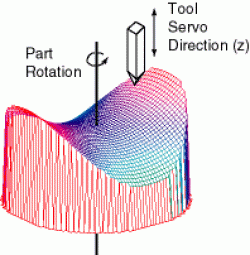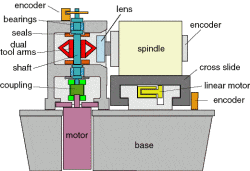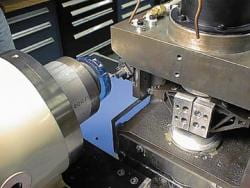PI(S):
Sponsor(s):
We have built a prototype turning machine specialized for the production of plastic spectacle lenses. This machine features a novel rotary fast-tool servo, which can track trajectories at frequencies up to 500 Hz, and accelerations of 500 m/s^2. Thus the machine can turn 100 mm diameter toric lenses having surface asymmetries of up to 3 cm in depth. The control system consists of a conventional inner position loop, feedforward filtering, and repetitive control. This high-bandwidth, high-accuracy system allows us to turn a toric surface with tracking errors of less than 2 microns.
Rotary Fast-Tool Servo for Diamond Turning of Asymmetric Optics
Acknowledgments
This project is funded by National Science Foundation under Grant award number DMI-9908325.
Description
Single-point diamond turning machines, such as lathes, are used to produce optically-clear parts. Conventional lathes carry the workpiece on a high-speed spindle and the tool on a slow axis allowing only rotationally symmetric shapes, such as spheres or paraboloids, to be machined. Asymmetric optics cannot be made using a conventional lathe, and are usually produced in a multi-step process of grinding and polishing. The diamond turning of asymmetric optics requires a fast-tool servo, which tracks a trajectory of higher frequency than the spindle RPM.
Figure 1 depicts the rotationally asymmetric surface of a eyeglass lens for the correction of astigmatism. This toric surface exhibits two peaks and two valleys per rotation of the lens. This means that if the spindle is turning at 1200 RPM, or 20 Hz, the tool servo must be able to follow a trajectory with a fundamental frequency of 40 Hz. Moreover, the servo must also track several higher harmonics (80 Hz, 120 Hz, 160 Hz, etc.,) to achieve the required accuracy.

Figure 1: Example of toric surface requiring a fast tool servo.
We have built a prototype turning machine specialized for the production of toric lenses, shown schematically in Figure 2, and photographically in Figure 3. This machine features a novel rotary fast-tool servo, which can track trajectories at frequencies up to 500 Hz, and accelerations of 500 m/s^2. The rotary topology eliminates the reaction force problems associated with linear fast-tool servos. Another advantage of the rotary structure is that it allows two arms to be mounted on a single axis, 180 degrees apart from each other on the shaft. Thus one arm can carry a robust and inexpensive polycrystaline tool for rough cuts, and the other can carry a delicate and expensive single crystal tool for finishing passes.

Figure 2: Schematic cross-section of rotary fast-tool diamond turning machine.

Figure 3: Photograph of rotary fast-tool diamond turning machine.
This machine can turn 100 mm diameter toric lenses with surface asymmetries up to 3 cm in depth. The control system consists of a conventional inner position loop, feedforward filtering, and repetitive control. This high-bandwidth, high-accuracy system allows us to turn a toric surface with tracking errors of less than 2 microns.
Current work is focused on reducing the manufacturing cycle time, improving the servo accuracy by an order of magnitude, and turning asymetric shapes in non-optic materials.
Publications
Stephen J. Ludwick, David A. Chargin, Joseph A. Calzaretta, and David L. Trumper, "Calibration and Control of a Rotary Fast-tool Servo," Proceedings of ASPE Fourteenth Annual Conference, October 1999.
